#largest locomotive
Text
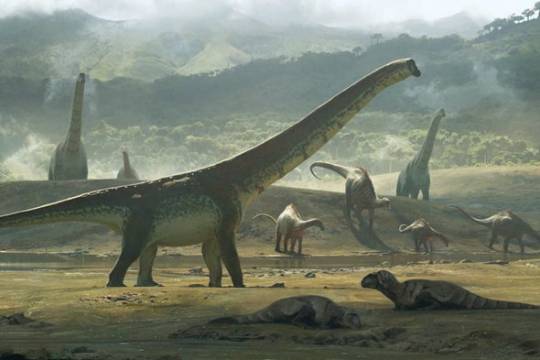
[ Argentinosaurus, a giant sauropod, illustrated by Chase Stone. ]
"Of all the animals ever to have roamed the planet, the iconic long-necked, long-tailed dinosaurs known as sauropods stand unrivaled. No other terrestrial creatures have come close to attaining their colossal sizes. They overshadowed all other dinosaurs, from the duck-billed hadrosaurs and the horned ceratopsians to the armored ankylosaurs and predatory tyrannosaurs. Even the mightiest land mammals—mammoths and rhinoceroslike beasts that were up to twice as heavy as the largest elephants alive today—were featherweights compared with the biggest sauropods.
From an evolutionary perspective, this singularity makes sauropods an intriguing anomaly. Evolution is rampant with examples of convergence, in which the same feature evolves more than once independently in different groups of organisms. A classic example of convergence is powered flight—flapping wings evolved in birds, bats, pterosaurs and insects, but the particular bones or other structures making up the wings differ among the groups, attesting to their independent evolutionary origins. Convergence in evolution is very common even when it comes to complicated features: warm-bloodedness, eyes that can move and focus, bipedal locomotion, the loss of limbs, the use of tools, and live birth all evolved multiple times in different animal groups. Convergence is widespread in the plant kingdom as well: carnivorous plants evolved at least a dozen times, roots evolved more than once, and even arborescence—plants taking the form of trees—evolved more than once. With convergence so common in nature, sauropods' uniqueness in size is special in itself. No other land animal has approached even a third of the largest sauropods' weight. What makes sauropods stand out from the crowd, both literally and figuratively?"
Read more: "How Sauropod Dinosaurs Became the Biggest Land Animals Again and Again" by Michael D. D'Emic.
#palaeoblr#Palaeontology#Paleontology#Sauropods#Dinosaurs#Art#Article#Argentinosaurus#Cretaceous#Mesozoic#Prehistoric#Extinct
1K notes
·
View notes
Text
Fish of the Day
Today's fish of the day is the Giant isopod!
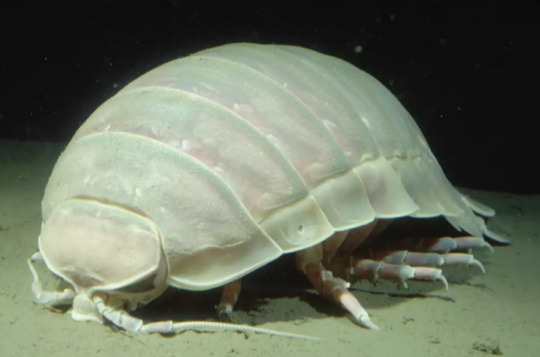
The giant isopod, describes around 20 species in the Bathynomus genus, but most information is based on the Bathynomus giganteus, which is known for being the first giant isopod discovered, and the largest. Giant isopods, as an arthropod, have seven pairs of legs, four jaws, and compound eyes that have over 4,000 facets. The first set of legs is modified into an appendage for grabbing food and bringing it into the mouth, along with attacking prey, and all species with the Bathynomus genus are similar, showing a lack of evolution between populations The full range of this family is unknown, but they can be found around the Indo-Pacific and the Eastern Atlantic ocean. The first time a giant isopod was found and recorded was in 1879 in the Gulf of Mexico, where the largest populations of giant isopods live, with a depth range of 310-2140 meters of depth. Outside of the Gulf of Mexico the other populations have a near identical depth range, and due to their similarity to their close land dwelling cousins, rolly pollies or woodlouse as you might know them, they are one of the textbook examples of deep sea gigantism.
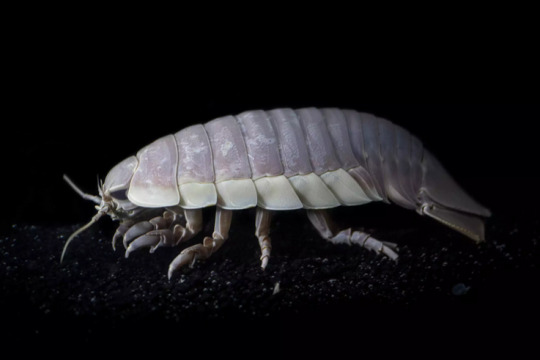
Deep sea gigantism is an observed phenomena where deep sea animals have a habit of getting far larger than their more shallow relatives. Examples of this would be the giant squid, giant sea spider, deepwater stingrays, the bigfin squid,oarfish, and many more. There is currently no encompassing explanation for why this phenomena is so prevalent, but there are multiple theories that have been proven partially correct by different genus. Food scarcity is often referenced, and often thought to be the reason for the giant isopods' large size. as without much food in the deep ocean organisms with the ability to store more food can live for longer periods without prey. Another explanation is the increase in dissolved oxygen, which is often a limiting factor in how large animals can become in their environments. A study of amphipod crustaceans in 1999 discovered their increase in size as the populations found in deeper waters directly increased with the amount of dissolved oxygen. The last and often most damning explanation for deep sea gigantism is the lowered temperature in deeper waters. This one can increase the size in animals by increasing cell size and lifespan, something that can also be found at the world's poles. Deep sea gigantism allows for the giant isopod to get anywhere between 19-36cm (7.5-14.3 inches) in length, with the largest recorded being 20 inches, about the size of a small dog. As compared to their close land relatives, which come in at less than an inch of length.
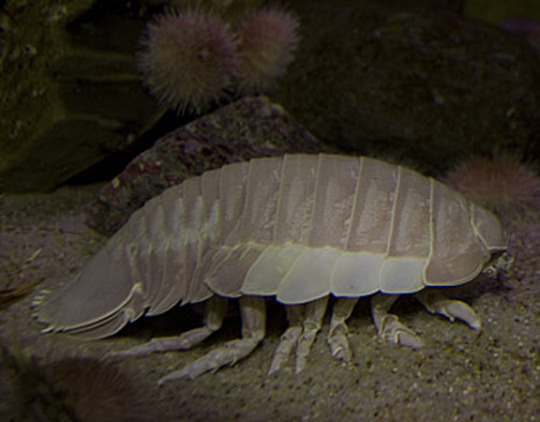
The diet of the deep sea isopod is remarkably similar to that of the land dwelling isopods, as the land dwelling isopods live off of dead or decomposing animals or plant materials. Which is similar to the diet of the giant isopod, which is an essential scavenger and carnivore in the deep. Once believed to be only scavengers, it is now known that giant isopods also actively pursue prey, usually fish, squid, shrimp, crabs, and other deep sea animals they can catch, as shown by a video of an isopod grabbing a dogfish shark and eating its face. These isopods can take down prey several times larger than them, but this may be only when in a confined space, as they don't swim fast and can only attack prey they can catch. But, as scavengers in the deep the giant isopod is primarily known for eating from whalefalls. A whalefall being when the carcass of a dead whale drifts to the deep seafloor, creating huge ecosystem hotspots and specialized animals in deep waters that feed almost exclusively on them. After eating from these whalefalls, giant isopods have been shown to go as long as 5 years in captivity without eating again, and for this reason when in the presence of food they eat far more than their body weight or size, willing to sacrifice locomotion in favor of excess, an easy trade considering they have no natural predators. Despite having no predators, they still have several behaviors similar to land pill bugs, as they can still roll into a ball shape, using their chitin armor to protect themselves, and burrow into the sediment to semi-hibernate.
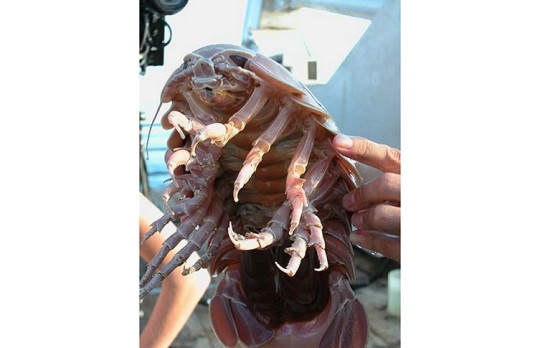
The reproduction of the giant deep sea isopod is like that of many other arthropods, relying on eggs. In the spring and winter months the isopod females will begin brooding eggs, this is done in a pouch above the stomach and it will store anywhere between 20-30 eggs. During the brooding the female will burrow down into the sediment and refuses to leave until all eggs are hatched, at which point the juveniles are left. Captive isopods eggs measure 13mm in diameter and are thought to possibly be the largest marine invertebrate egg. Once born, these juvenile giant isopods will be as large as 4 inches in length ,and set off on their own in a stage called manca. At this stage, these are almost fully developed giant isopods, lacking only the last pair of legs. These will grow over time, and these animals gain size through molts. Their full lifespan is unknown, but estimated to be decades long, with the age of sexual maturity being unknown but estimated anywhere from 15-18 months.
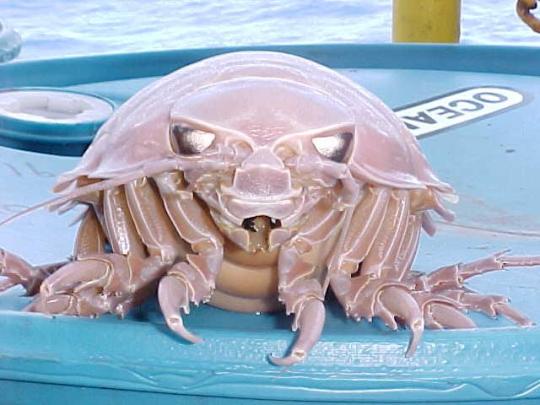
Have a good day, everybody!

#artropod#giant isopod#deep sea#deep sea giant isopod#isopod#giant#isopods#rolly polly#pill bug#sea creatures#marine life#sea life#fish#fish of the day#fishblr#fishposting#aquatic biology#marine biology#freshwater#freshwater fish#animal facts#animal#animals#fishes#informative#education#aquatic#aquatic life#nature#river
326 notes
·
View notes
Text
I love to imagine the magic mountain bases all actually existing completely separately from each other in completely different time periods (almost), despite being physically in the same location.
In the ancient world, pyramids are constructed at the base of a huge volcano to honor the dead and worship old gods. A wide path leads to an entrance into the volcano, far enough in that the heat gets dangerous. Inside, sacrifices are made to the gods, to their king, offerings given up for the benefit of them all. The king is kind and forgiving, loyal to his people, asking for little and giving as much as he can. The gods however, are cruel, and all civilisations must fall eventually. For this one it's after a great eruption, one that shakes the earth with all the fury of the gods, that the pyramids become abandoned, left alone for centuries to erode. Over time new life grows, and thick jungles begin to hide the pyramids from view, until eventually, they’ve become a part of the natural landscape. Venture far enough in, however, and you might find remnants of the ancient civilisation: old writing in a language no one knows anymore, praises given to their old king; the remnants of ancient weapons and armour; the shapes of people who once lived forever preserved in ash and pumice.
~
It's the start of the industrial revolution, and rumours start spreading of an eclectic man and his steamrail full of exotic animals from across the globe. He’s a travelling zoo, of sorts, appearing in the strangest of places (as long as there's a railway line, he'll be there), areas it logically shouldn't be able to reach. He’s got all sorts of animals, from dolphins and turtles to strange, mysterious beasts. Where does he keep them all when they're not on the train? Some say he doesn't exist. others insist he does, that he lives underneath a mountain no one dares to visit. It's an active volcano, they say, dangerous to go near. If anyone dared to explore they might stumble upon the largest, most diverse collection of animals they've ever seen, and, most bizarrely, a large steam locomotive that runs on its own railway track, seemingly on a loop through the volcano itself. The tunnel is so dark the train disappears into it entirely. a young exploration group decide to find out for themselves, years later, and at first they think there's nothing there, until one of them stumbles upon the obvious remnants of a railway line, no longer in use but not so old that it's started to break down. Maybe he did exist after all...
~
In the late 1800s, a small fishing community establishes itself by the mountain. Electricity is new, and with the new machines and motors available to them the community quickly grows into a small village. Something is wrong, though. The rocks embedded in the mountain appear to resemble a skull more and more by the day, water streaming from one eye socket as though it’s crying. Underground passages and tunnels are found by the new residents, all leading to strange chambers. There's something in the water. A young man, one of the first in the village, disappears for a month, and when he returns, he's changed. He insists the ocean speaks to him, to everyone through him. He fishes for hours, days, weeks on end. When his madness begins infecting others, most gain the sense to stay away from him, but not everyone does. There's something in the water.
By the mid 1920s, the small fishing village is still standing, although most of the residents from four decades ago have since left. A young woman, traveling alone in her tiny fishing boat, docks at the village in need of repairs. What was meant to be a one night stay turns into days, then weeks, then months, as she begins to notice strange happenings in the village. A local artist has locked himself in his house, gone mad from something he found in the ocean. A scientist is experimenting with strange materials, and sometimes at night strange noises come from her house. There's something in the water. An older man speaks in tongues, driven mad by the sea. There's something in the water. The young fisher sees him occasionally, staring through her, unseeing. She's begun dreaming of ancient monsters in the depths of the water below her, reaching their long arms out and crushing her and everyone else. When she looks into the sea she can't see anything. It’s just inky blackness.
(No one knows how the village gets destroyed. One day it's here, and the next it's turned to rubble, razed to the ground by forces beyond human perception. It appears no one survived, but strangely, there's no trace of the small fishing boat the young woman had arrived in, nor of her body, and if anyone stopped for long enough in the wrecked city they might hear mumbling at night from underground, the mad ramblings of a man who has seen too much.)
~
Magic mountain row thrives in the early 2000s. They’ve beaten the Y2K bug (it really wasn't that much of a problem, anyway), business is booming at all the independent stores, and the local economy is better than ever. It doesn’t matter that not many people want to live here because new tech keeps Big Ron busy, and Willie Jr is old enough to start working at his father's shop, preparing himself to take over the business. The safe storage containers are always a little open, but nothing ever really goes missing, because no new people means everyone knows everyone. A young boy visits his neighbours for the last time before he leaves with his family; his dad's got a better job somewhere far away and they have to leave now, and besides it’s safer not to live by a barely-dormant volcano (it’s not as cool, though). His new neighbourhood has a lot more kids his age, but he can't help but miss the eccentric nature of his old neighbours. He returns to his childhood home twenty years later to find it empty. Most of magic mountain row is empty now, actually. There are a few places still open: Big Ron refuses to close up shop because Willie Jr, who has taken over the business now that his father's passed, still needs his help from time to time. Anyone still living here is merely clinging to a past they remember so fondly they can't adapt for the future. They're happy, though. They’re happy to remain here until it's their time to go.
~
In the not-so-distant future, a dense city is formed on the mountain. It started out as a smaller town, with traditional architecture and shrines dotted around the place, but as technology advanced and society progressed it grew and evolved into towering skyscrapers, holographic billboards, a rail system that winds through buildings and above streets. Elements of the past still remain - lush gardens lined with cherry blossom trees, the old shrines and temples still standing, a mark of the city's history and longevity. The city stands the longest, weathers the strongest storms, grows and evolves and changes, but all must come to an end, eventually. A rumbling in the earth, a once-dormant volcano waking from its slumber. They have the tech to know it's coming, now, so they all flee before it can hit. Only one man stays behind. This is his city. This is his home. He built this entire place from the ground up, and he’s not going to leave it behind. He makes his way to one of the shrines. Praying to his goddess, he leaves her one final offering, and when the ash settles all trace of him is gone.
~
The apocalypse happens in a future beyond our reckoning. A city lies, abandoned by most, on top of the ruins of civilisations that came before. Once a lively hub of activity and tech and innovation, the city has become a ghost town, occupied only by the artificial intelligences that had driven humanity out. They wander aimlessly, mimicking the behaviours of the humans they used to watch and help, protecting the inner core of their city that keeps everything, including themselves, alive. The humans reside elsewhere, in a bunker resembling the old world, with more vegetation and life than the city had despite being hidden underground. The city’s architects reassure everyone that they’ll be able to return someday soon. The one who designed the robots, a man more cyber than human by this point, just needs to fix a few issues with their programming. He doesn’t want to destroy them but he might have to. His partner, who designed most of the city, will need to commence repairs before anyone can live in the city again. So they leave, vowing to fix the city so that everyone can return to society. No one knows they will never return.
#i started including some of them as characters in their own bases and had to make it like that for all of them#i cant help myself#also grian and gem's are linked bc their bases are just SO connected to me#also some of them might be implied to be immortal or gods or uh. fae-type-magical#again. i cant help it#grian#geminitay#skizzleman#goodtimeswithscar#gtwscar#smallishbeans#mumbo jumbo#impulsesv#bdoubleo100#hermitcraft#hc 10#magic mountain#long post#mine#this is 1.5k words btw my bad
302 notes
·
View notes
Text
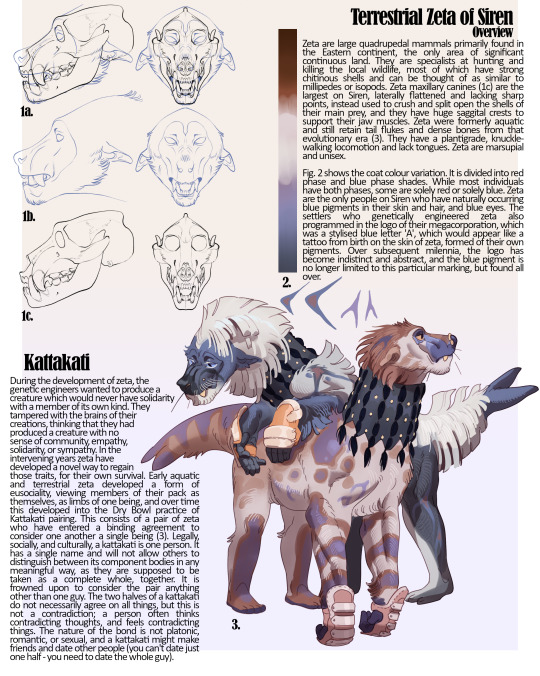
I gave up on editing and did this instead check it out. I had a rough time with the zeta because they kept getting too anthro dog-ish and I wanted them to read as primates. The one pictured there is a crew member on a whaling vessel (chef and lookout).
Image description and transcript of text below the cut:
[Figure 1 description: Front and side views of a zeta's face with the skull and external anatomy overlaid and separate. The skull is similar to a baboon's with massive broad fangs and a huge saggital crest on top for muscle attachment.
Figure 2 description: a bar of colours ranging from dark brown, to reddish, to pale cream, to violet, to blue, to dark blue. Beneath it are several blue markings resembling a stylised 'A' or an arrow.
Figure 3 description: a pair of zeta standing together. They are blue, brown, and cream in colour and wearing fancy black collars with dark tassels, and knuckle-guards to protect their feet. They have stocky muscular bodies and ape-like heads. One is propped up on their elbows over the back of the other, looking in a different direction.]
Text reads:
Terrestrial Zeta of Siren: Overview
Zeta are large quadrupedal mammals primarily found in the Eastern continent, the only area of significant continuous land. They are specialists at hunting and killing the local wildlife, most of which have strong chitinous shells and can be thought of as similar to millipedes or isopods. Zeta maxillary canines (1c) are the largest on Siren, laterally flattened and lacking sharp points, instead used to crush and split open the shells of their main prey, and they have huge saggital crests to support their jaw muscles. Zeta were formerly aquatic and still retain tail flukes and dense bones from that evolutionary era (3). They have a plantigrade, knuckle-walking locomotion and lack tongues. Zeta are marsupial and unisex.
Fig. 2 shows the coat colour variation. It is divided into red phase and blue phase shades. While most individuals have both phases, some are solely red or solely blue. Zeta are the only people on Siren who have naturally occurring blue pigments in their skin and hair, and blue eyes. The settlers who genetically engineered zeta also programmed in the logo of their megacorporation, which was a stylised blue letter 'A', which would appear like a tattoo from birth on the skin of zeta, formed of their own pigments. Over subsequent milennia, the logo has become indistinct and abstract, and the blue pigment is no longer limited to this particular marking, but found all over.
Kattakati
During the development of zeta, the genetic engineers wanted to produce a creature which would never have solidarity with a member of its own kind. They tampered with the brains of their creations, thinking that they had produced a creature with no sense of community, empathy, solidarity, or sympathy. In the intervening years zeta have developed a novel way to regain those traits, for their own survival. Early aquatic and terrestrial zeta developed a form of eusociality, viewing members of their pack as themselves, as limbs of one being, and over time this developed into the Dry Bowl practice of Kattakati pairing. This consists of a pair of zeta who have entered a binding agreement to consider one another a single being (3). Legally, socially, and culturally, a kattakati is one person. It has a single name and will not allow others to distinguish between its component bodies in any meaningful way, as they are supposed to be taken as a complete whole, together. It is frowned upon to consider the pair anything other than one guy. The two halves of a kattakati do not necessarily agree on all things, but this is not a contradiction; a person often thinks contradicting thoughts, and feels contradicting things. The nature of the bond is not platonic, romantic, or sexual, and a kattakati might make friends and date other people (you can't date just one half - you need to date the whole guy).
#told ya it was unethical#setting: siren#i know empathy is a charged word here but it's hard to discuss the effects of the GMO without falling back on it#they basically turned off the part of the brain that says We Live In A Society and a bunch of other stuff besides#is it scientific? no. i just wanted to explore what is necessary to reverse-engineer 'society' back into a population#speculative biology
399 notes
·
View notes
Text
Round 1 - Phylum Echinodermata




(Sources - 1, 2, 3, 4)
Echinodermata is a phylum of animals which are bilaterally symmetrical as larvae but radially symmetrical as adults. It includes starfish, brittle stars, sea urchins, sand dollars, sea cucumbers, and sea lilies.
Echinodermata is the largest marine-only phylum, and echinoderms can be found at every ocean depth from the intertidal zone to the abyssal zone. They make up a large portion of life in the deep sea. They are diverse, with some being sessile (lacking self-locomotion) while others are motile (able to move independently). Many are restricted to crawling slowly across the sea floor, while some can swim through the water column. They have a skeleton beneath their outer layer of skin, which is composed of calcite-based plates called ossicles. This would be heavy if it was solid, so it is instead porous. The ossicles may be fused together or articulated, and may have external projections such as warts or spikes. Echinoderms are often brightly-colored, and some of their pigment cells may even be light-sensitive, causing many echinoderms to change appearance completely as night falls. Their diet varies, with some species being predators, some being filter-feeders, some being herbivores, some only eating algae, and some being detritivores. Some injest food through a mouth and expell waste through an anus, while others can only expell waste back through their mouth. The ventral side of many echinoderms is covered in tube feet, each of which typically end in a suction cup pad. They primarily use their tube feet for movement, though some sea urchins will also “walk” with their spines.
Almost all species have males and females, though some are hermaphroditic and at least one reproduces by parthenogenesis. Eggs and sperm are released into open water, where they are fertilized externally. Some species may aggregate during reproductive season to increase the likelihood of fertilization. A small handful of species have internal fertilization. Some echinoderms, especially in colder areas, brood and carry their eggs until they hatch. Echinoderm larvae are usually planktonic, swim via cilia, and have bilateral symmetry. During metamorphosis, the left side of their body grows at the expense of the right side, which is eventually absorbed, ending with the body arranged in five parts around a central axis. Some species reproduce asexually. They do this by splitting in two, like a cell, and generating a new body half from the old one. Some larvae may also reproduce by budding.
The first echinoderms appeared in the Early Cambrian.

Propaganda under the cut:
Echinoderms are able to regenerate tissue, limbs, organs, and sometimes full bodies from a remaining portion of limb. Starfish and brittle stars may detach an arm as a defense mechanism, swimming away while a predator is distracted by the wiggling limb. Some sea cucumbers, on the other hand, take this to the extreme by expelling their cuvierian tubules (respiratory tubes) to entangle potential predators. Sometimes this is also accompanied by a discharge of toxic holothurin. It can take 1.5 - 5 weeks for the tubules to regenerate, depending on species.
The hard endoskeletons of dead echinoderms are geologicallly important, contributing to limestone formations.
Echinoderms sequester about 0.1 gigatonnes of carbon dioxide per year as calcium carbonate, making them important contributors in the global carbon cycle.
Sea stars are heavily muscled, and are able to go from soft to rigid in order to pull open the shells of their mollusc prey.
Sea urchins are among the main herbivores in reefs and there is usually a fine balance between the urchins and the kelp and other algae on which they graze. In the past, mass mortalities of sea urchins have led to algae blooms.
Some sea cucumbers have webbed swimming structures that allow them to swim freely through the water column. Pelagothuria natatrix (seen below) is the only truly pelagic echinoderm known so far.

(source)
Echinoderms seem to have an innate internal clock. Even at the depths of the ocean where no light penetrates, they are still able to synchronize their reproductive activity.
We don’t know much about Sea Pigs (Scotoplanes globosa) (seen in gif) other than that they’re poisonous sea cucumbers that feed on detritus at the sea floor. But we do know that they are often seen clutching young king crabs (Neolithodes diomedea) and carrying them around. One possible theory is that these crabs latch onto S. globosa to gain access to nutrients and movement, and sheltering beneath the poisonous sea pig allows them to hide from predators. As sea pigs are sometimes plagued with parasites that bore holes into their bodies, the crabs may also help the sea pigs by keeping them clean of parasites. For now, all possibilities are just hypotheses, but we can stil Awww at the globby pink sea cucumbers cuddling their little pet crabs.
Along with Hemichordata, they are the closest relatives of Chordata (aka our phylum!)
Some sea urchins pick up rocks, shells, and other debris and carry them around to shade themselves from the sun. Some people who keep them as pets have come up with creative ways to allow them to do this without dismantling the architecture:

(source)
Silly hats aside, these seemingly simple animals are using tools.
112 notes
·
View notes
Text
Wet Beast Wednesday: electric eel
Prepare to be jolted this Wet Beast Wednesday as we dive into the shocking world of electric eels. The fist thing to know about electric eels is that the name is a lie. Not the electric part, that's true, but the eel part. Despite appearances, electric eels are actually knifefish, a group of freshwater fish that are more closely related to catfish and piranha than to true eels.

(Image: three electric eels swimming in an aquarium. One in front is seen in profile. It is an elongates, slender, brown fish with tiny pectoral fins and a long anal fin that runs under most of the body. End ID)
There are three species of electric eel, though they are so similar to each other that they were previously classified as one species. The species are Electrophorus electricus, Electrophorus voltai, and Electrophorus varii. The main difference between the species are in the shape of the skull. All electric eels are elongated fish that are cylindrical at the front and flattened vertically at the tail. They have no pelvic or dorsal fins and the tail fin is small and fused with the anal fin, which runs across most of the body. The anal fin is the primary means of locomotion for the eels. By undulating the fin in a wavelike motion, the eel can swim forward, backward, or hover in place. The body of the eel is scaleless, instead bing covered in muddy brown skin. Electric eels grow throughout their entire lives and grow new vertebrae as they get longer. The largest species, E. electricus, can reach 2 meters (6.6 ft) long and weighs up to 20 kg (44 lbs). They are obligate air-breathers, being incapable of obtaining enough oxygen through their gills to survive. Instead, they must surface every two to ten minutes to breathe. The inside of the mouth is wrinkly and heavily vascularized, resulting in a high surface area that can absorb oxygen as long is it stay wet. The floor of the mouth can flex to draw air in and then it is forced out through the gills. Carbon dioxide is excreted through the skin. Electric eels have poor eyesight, but have electroreception and very good hearing thanks to Webers apparatus, a set of tiny bones that connect the inner ear to the swim bladder. The apparatus amplifies sounds that the ear would not be able to detect on its own.

(Image: a close-up of an electric eel's head. It is round and brown, reminiscent of a potato in texture. The mouth is located on the frond and is closes, with no visible teeth. Tje eye is very small and pale blue. Across the head are sensory pits that look like small holes. End ID)
All of the vital organs of the eels are packed into the first fifth of its body length. The rest of the body contains the electric organs. Keeping the vital organs in the front of the body isolates them from the electric organs, preventing the fish from damaging their organs while generating electricity. The electric organs take up so much more space because they need to generate very powerful electric shocks. Most fish that hunt with electricity are saltwater species as salt water conducts electricity much better than freshwater. Because electric eels are freshwater fish, they need to generate much more powerful shocks to effectively hunt other animals. E. voltai can produce a maximum recorded 860 volts of electricity, the highest of any animal. Electric eels are electroreceptive, able to sense electric fields in their surroundings. Electroreception is divided into passive (animal senses electric fields of others) and active (animal generates its own electric field and can sense distortion in that field caused by other objects or animals). Electric eels are active electroreceptors. They sense changes in their electric field using sensory pits on the head that are derived from the lateral line system that all fish have. Electric eels have three electric organs: the main organ, Sach's organ, and Hunter's organ. The main organ sits in from of the Sach's organs while the Hunter's organ sits beneath both. The organs are derived from muscles and consist of stacks of structures call electrocytes, which are made up of specialized cells. When the brain sends a signal to the electric organs to produce a shock, special ion channels pump sodium ions into the cells while different channels pump potassium out. This creates a sudden difference in electric potential, which is what generates the shock. Producing electricity is a costly process and the eels need rest and nourishment between multiple successive shocks. The main organ generates the powerful shocks used to stun prey while the Sach's organ creates weaker shocks used for active electroreception. Hunter's organ appears to support the other two.
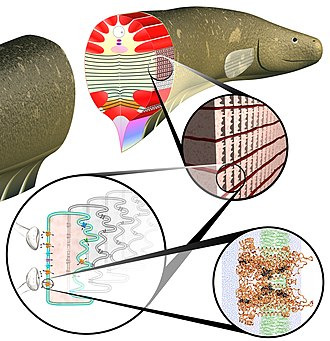
(Image: an artistic depiction of a cross-section of an electric eels, showing the structure of the main electric organ. From there, the image is zoomed in on multiple times, showing the the structure of the electrophytes, the protein channels, and the structure of the proteins involved in generating electricity. End ID. Art by Daniel Zukowski)
Electric eels are found in northern South America and the ranges of the three species generally do not overlap. They prefer muddy bottoms or swampy areas. The terrain of their territory changes quite a bit through the year. In the wet season, water levels rise, flooding sections of forest and grassland and connecting streams and ponds. In the dry season, water levels drop and many streams and ponds are isolated. These isolated bodies of water become warm, low-oxygen areas where fish that rely on gills are at a disadvantage while air-breathing fish like the electric eels can thrive. Electric eels are nocturnal predators that detect and stun prey through their electric abilities. Their diet consists mostly of fish, but they will take just abut anything. While mostly solitary, E. varaii have been observed coordinating with each other to hunt schools of tetras. When the electric field generated by Sach's organ is disturbed by another animal, the eel will use the main organ to produce a strong shock to stun the prey. Stunning can be done from a distance, but is more effective if the eel makes contact with the other animal. An initial shock may be used to temporarily immobilize prey long enough for the eel to contact it and release a second shock. Some sources propose that the eel can use its shock to forcibly contract muscles in other animals, either immobilizing prey or forcing prey to move, making them easier to sense. Where or not this is something the eels can actually do is up for debate. Electric eels also use their shocks to deter potential predators. When feeling threatened by something on land, the eel can leap out of the water to make contact with the threat and shock it. Very few animals prey on electric eels, but known predators include caiman, alligators, and piranha.

(Image: six frames showing na electric eel in captivity responding to a perceived threat (a fake caiman head) by partially leaping out of the water and contacting the head to shock it, before returning to the water. End ID)
Electric eels breed in the dry season. Males will use their saliva to glue together mud and sand into nests where the females lay their eggs. The male then fertilizes the eggs by releasing sperm onto them. The females may lay eggs multiple times during the breeding season and can lay up to 1200 at a time. The male stays by the nest to guard the eggs and hatchlings for up to four months. The lifespan of electric eels is in question, but captive specimens can live for up to 20 years.

(Image: an electric eel resting on a pile of wood next to some rocks. End ID)
All species of electric eel are classified as least concern by the IUCN, meaning they are not at threat of extinction. Threats to them mostly consist of pollution and habitat loss. Studies of the electric properties of the eels have lead to multiple discoveries and inventions. In particular, Luigi Galvani was inspired by studies on the eels when he invented the battery. Electric eels are also important in the study of the voltage-gated sodium channel. These channels are used to generate electricity, but are also used to trigger the contraction of muscle cells in many species, including humans. It is hard to study the channels in muscle cells because they are found in very small amounts. The electric organs of the electric eel have much higher quantities of these channels, making it much easier to study them. Better understanding of voltage-gated sodium channels could lead to improvements in prostheses and medical implants.
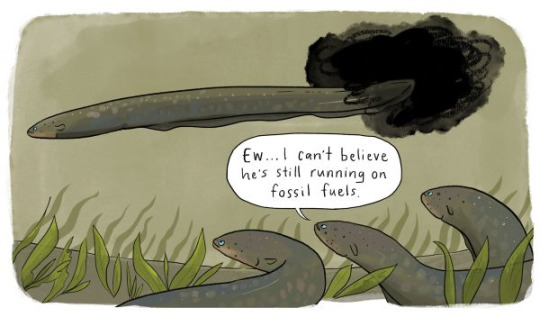
(Image: a cartoon showing an electric eel swimming with a black cloud emerging from its tail. Threee other eels watch from the side, one commenting "Ew... I can't believe he's still running on fossil fuels". End ID. Source)
#wet beast wednesday#electric eel#fish#fishblr#knifefish#freshwater fish#biology#zoology#ecology#animal facts#informative#science
105 notes
·
View notes
Text
Aviation in the USSR
A collection of excerpts from Anna Lousie Strong's The Soviets Expected It, compiled for @czerwonykasztelanic
[...] Or the guerrilla detachment which captured six German planes, destroyed five of them, and sent the sixth to the Red Army, piloted by an amateur air enthusiast, who was a tractor driver in ordinary life.
Lt. Talalikhin’s initiative is already a Soviet aviator’s tradition. Exhausting his ammunition in a fight with three enemy planes, he rammed the tail of one enemy with his propeller, smashed the tail of another enemy plane with his wing tip, and then bailed out of his own plane safely. Moscow parks displayed the wreckage of the German planes, and other Soviet pilots quickly copied the tactics. An aviation technician, Konikov, won renown by attaching the fuselage of a plane he was repairing to the front platform of a military train whose locomotive had been bombed by the enemy; he thus pulled the most necessary parts of the train to safety.
pg. 14
The Soviet people glimpsed and felt victory. For the first time they began to feel that they were no longer “backward Russians.” They were beginning to challenge the world. With this went a proud sense of their unity as a nation. Cotton growers in Turkestan exulted, “We have conquered the Arctic,” though they themselves would never see the snow. Bearded peasants, who had never sat in an airplane, began to talk about “our conquest of the air.” Young Nina Kameneva expressed the mood of the country’s young people when she broke a world’s altitude record in parachute jumping and remarked on landing: “The sky of our country is the highest sky in the world.”
pg. 46
Moscow can make all the implements of war, including planes and motor trucks, inside the city. [...] Moscow’s sky is covered by an air defense that was the marvel of the London experts who visited it after the war began to make suggestions and found it far superior to London’s. Anti-aircraft shells make a thick blanket at four distinct levels to London’s one, and observation planes patrol the heavens night and day. Moscow’s four million people also offer a night-and-day defense.
pg. 51
Alma Ata, the capital of this area, has grown from a town of 60,000 to a proud young city of 260,000 in the ten years since the railroad reached it. Its life has leaped at once from the nomad epoch to the airplane. The railroad is too slow to tame the wastes of Kazakstan. From Alma Ata Airport the planes shoot forth, east, west, south, north, on new discoveries. [...] Kazakstan is only one of the energetic regions behind the Urals. South of it lie the lands of the Uzbeks and Tadjiks, where some of the largest textile mills of the U.S.S.R. work up the locally grown cotton and where automobile and airplane parts are produced by mass production in the historic city of Samarkand.
pg. 58
I have traveled many times on the Trans-Siberian. In the spring of 1935, I went from Vladivostok to Moscow with a stop-over in the Jewish autonomous territory whose capital is Birobidjan. The train was crowded with pioneering people in warm woolen clothes and padded leather jackets, engineers, Army men, developers of the Far East. [...] An army engineer who shared my table at dinner was celebrating his return by airplane from the northern wilderness by consuming a whole bottle of port and bragging about the Far Eastern pioneers.
pg. 59
According to Pierre Cot, the French Air Minister, who visited Moscow in 1933, the Soviet air arm was at least equal to the best in Europe in numbers, technical equipment, and, above all, in the productive capacity of the aviation industry.‡ Thus, by the end of 1932, which ended the first Five Year Plan, the Soviet Union had reached the level of Western Europe in armaments – a fairly modest level judged by standards of later years.
pg. 65
Other official indications of the extent of the Red Army’s mechanization come from Voroshilov’s report in 1934 [...]. Five years later [...]. He claimed that the “bomb salvo” of the Soviet air force (the number of bombs that can be dropped by all planes at once) had tripled in five years and had reached more than 6,000 tons.
pg. 66
Soviet airplane pilots also hold many world records, both in altitude and long-distance flights. Their conquest of the Arctic and its difficult weather has accustomed them to the severest conditions. Americans well remember the Soviet pilots who twice made world records by flying from Moscow to America. These were individual exploits, but the development of Arctic aviation on which they were based was the work of large numbers of pilots and implies a whole air tradition
pg. 67
Parachute jumping has become a national sport in the Soviet Union. Soviet people are probably the most air-minded people in the world. Training for air-mindedness begins in the kindergarten. Small tots play the “butterfly game” and jump around with large butterflies pinned on their hair, gaining the idea that flying is fun and a natural activity. Children in their teens make jumps from “parachute towers” which are far rougher and more realistic than the parachute tower in the New York World’s Fair, which was copied from them. The sport is popular not only in the cities but on the farms. Several years ago a Ukrainian farmer told me of his trip to the nearby city with a group of farm children, all of whom immediately formed in line in the recreation park to go up in a tall tower and jump off under a parachute.
“I thought it very terrifying,” he said, “and wondered why the park authorities allowed it. Then I saw that my own thirteen-year-old daughter was at the head of the line. These children of today aren’t afraid of anything.”
At an older age, Soviet young people jump from airplanes, learn to operate gliders, or even become amateur pilots in their spare time. Every large factory, government department, and many of the larger collective farms have “aviation clubs,” which are given free instruction by the government. Probably a million people in the Soviet Union have made actual jumps from parachutes. It is not surprising that the Red Army was the first to use parachute troops in active service several years before the Germans adopted them. In 1931 a small detachment of parachutists surrounded and cleaned up a bandit gang in Central Asia.
The making of airplane models by young people is taken seriously in the U.S.S.R. In 1937 over a million school children were spending after-school hours in aviation model stations. At a later stage, young people of talent create real airplanes and demonstrate them at Tushino aviation exhibitions. Owing to the wide interest in aviation and the public ownership of factories, a bright Soviet youth who invents a new type of airplane may get it constructed by his factory sports club and show it off. At one of the aviation festivals I attended, I saw a score of different amateur planes, including every possible shape of flying object – short, stubby ones, long thin ones, others shaped like different kinds of insects. They added greatly to the gaiety of the occasion. Whether or not they produced any really valuable new invention, they at least encouraged the inventiveness of their makers.
pg. 72
In the past two years, especially, all this training has been given a very realistic turn. [...] Only a month before the Germans attacked the Soviet borders, 7,000 Moscow citizens practiced a special drill in repulsing parachute troops over the week end. The large numbers of such trained citizenry, both among recruits entering the Red Army and among the older citizens assisting it, greatly add to the Soviet Union’s total defense.
pg. 73
45 notes
·
View notes
Text



Numidotherium, oh jolly, how I love you! It is the early proboscidean ever! Don't be alarmed by it's weird look, I will break it down for you!
What you are looking at here is an early elephant relative from the Eocene of northern Africa. It is bizarrely build, with surprisingly long legs adapted for terrestrial locomotion (compared to Meoritherium for example, which was more semi-aquatic) but they are sprawling like in a dinocephalian. It's skull is very short and domed with evidence for sexual dimorphism (males having larger domes). it appears to have been a browser and was the largest land animal in the formations it was found in. The trunk was probably very short, similar to a tapir and the tusks weren't present yet.
#paleoart#sciart#numidotherium#elephant#proboscidean#ecocene#cenocoic#weird stuff#extinct#animal#mammal#wtf evolution
899 notes
·
View notes
Text
NEW FOURTH VERSION OF THE (ONLY) SUNLESS SKIES MOD OUT NOW!

Get in on Nexusmods
https://www.nexusmods.com/sunlessskies/mods/1
or ModDB
https://www.moddb.com/mods/monarch-steel-wine
Monarch Update 4: Glorious Dawn Features Include:
Expanded London:
- New random events for London; some original, and some based and heavily expanding upon previously flavour-only events that now actually give you options and stuff!
- New location tab for London: Nelson's Square where we sorted all high society related stuff to unclutter St Dominic’s; and finally proper New Sequence content (for all the 5 weirdos - me included that care)!
- A dominance mechanic similar to New Winchester that currently influences Shop prices in London, reflecting which Albion Factions you throw your support behind
Pirate Ports:
- Kenyon's Hand in the Reach can now be interacted with for piratical activities.
- Canback's Gambit in Albion can now be interacted with for macabre and Resurrectionist activities.
New Facets:
- Over 70 new Facets to fill out your Captain's background, many based on either your Origin or lore things from Fallen London, Sunless Seas or more fleshed-out things already in Sunless Skies we fleshed out more
The Cartographer in New Winchester:
- A new shop in town, the Coffee & Cartography Company offers quests and a reward for clearing up the map to make a comprehensive Atlas of the Known Skies (Best started in a new lineage, but there is a legacy option for ongoing runs)
Ratpair Barges are a new, neutral NPC locomotive that offer repair on the fly when hailed (press toot button)
Two new Mascots can be found around the Skies
Sophia's Alehouse at Langley Hall offers high level hunting quests, where you are pitted against large waves of sky beasts.
Similar to London, New Winchester's and Magdalene's flavour-only events have been given actual mechanical impact and been integrated into the Something Awaits You mechanic
Pan finally gets purchasable Lodgings at last
New Mod-Modules: faction related modules have been added, which can be obtained when your reputation is good (or at least not bad!) with a given faction.
QOL improvements to Mod-UI and jettissoning of Fuel/Supplies
Many small balances and fixes of previous mod content, and a lot more small additions
This update saw the largest Quest and Event addition of the mod so far. We more than doubled our added Event count. Some mechanical features like boarding have been postponed until the next update, since they need more polishing. We also recently made some mechanical breakthroughts that need proper exploration, like adding new docks and save points (and not just dockable discoveries), custom prospects, bargains and discoveries.
If you find bugs you can either tell us on Failbetter Discord’s Sunless Skies channel, our mod team Discord, on Nexus or Moddb, the Sunless Skies Subreddit or here on tumblr (feel free to dm me).
34 notes
·
View notes
Text
Traintober 2023: Day 1 - Free Day
Preservation on Sodor:
Sodor must be one of the most interesting places to look at when it comes to railway preservation, if not also road, sea and air preservation. For starters, the island’s railways are all still primarily run by vintage steam traction – but there’s also Harold, who is in his 60s or 70s at this point, Bertie the bus (who is nearing 100), Trevor and Terrence and George – not to mention the fact that the island seems to continue to have antique ships within its waters, including steam ships and fishing trawlers.
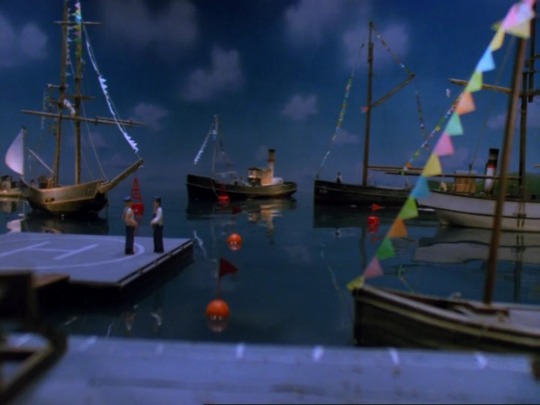
But of course, I want to focus on the railways – and in particular how Sodor must be the British hub for heritage railways, museums and other attractions. For starters, Sodor has by far the largest heritage railway system in the world for its size, with over 80 miles of mainline, several branchlines, a narrow-gauge railway, a mountain railway and a miniature gauge railway. It also has a massive fleet of engines – 80 by the Reverend’s count on the NWR alone – making it possibly the single largest working heritage railway in the UK, if not Europe. This would instantly attract many preservationists wishing to run their locomotives, meaning that mainline excursions and visitors would be a frequent sight on the island. This in turn would bring in tourists, who would make money for the NWR and the railway the engines belong to, as well as helping the Fat Controller if one of his enignes is unable to work. It would also give us as railfans the chance to see unique motive power on a variety of trains - like a Coronation Class pulling a slow goods, or a Hughes Crab on a China Clay train - things we don't get to see anymore.

Furthermore, Sodor is home to Crovan’s Gate Works, the largest steamworks of its kind in Britain. For its influence, I am going to turn to 60163 Tornado. When Tornado was built, her boiler had to be manufactured in Germany because there was just no one in the UK able to produce a boiler of the type, while the superheater header needed to be attempted by three foundries before it was assembled correctly. Crovan’s Gate Works, which is able to maintain a full fleet of engines including Gordon – who is also an A1 with many similarities – would have been able to do both in a far timelier manner. The same would go for all locomotive repair programs in the UK. Crovan’s Gate would either host locomotives or manufacture parts for them, becoming a hub for preservation across the country. Engines like Stepney or Green Arrow would be able to be overhauled at the Works, rather than be taken out of service. This would effect how many steam engines are in working order in Britain, if not Europe, as the refurbishment time would be significantly shortened - something that is compounded if said locomotive shares any components with a Sodor engine - like Talyllyn, Dolgoch, Flying Scotsman or any of the Black 5s, Panniers or Autotanks in preservation.
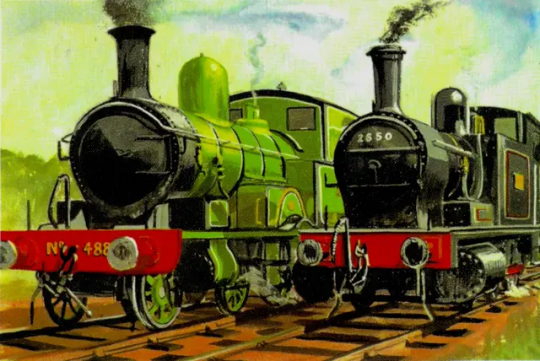
This brings me on to the last point: International Tourism. Sodor must be one of the most visited locations in Britain in this universe. For starters, there’s all the fans of the book and TV series (which are both canon and referenced in the books). This means that Sodor would have tens of thousands of families coming to the island from around the world annually to see the ‘Eight Famous Engines’ or the ‘Steam Team’, bringing in a massive amount of revenue for hotels, local businesses and the railways themselves. But there would also be the railfans who come with the aforementioned railtours, as well as international railfans who want to see steam in action in a mainline setting – something nearly impossible anywhere on the planet. Sodor has at least one airport (and probably two, considering in real life there is an airport on Walney Island near the real-life Vickerstown), six ports connected to the NWR, and a rail and road link to the UK. The island has the infrastructure to handle the flocks of tourists, and this would in turn benefit much of the rest of Northern England. This would majorly benefit the preservation world by bringing in funding for Sodor, which is in turn able to fund things like track upgrades, or overhauls for engines beyond their own railway. It also gives other railways a good place to promote themselves, as Sodor has a guaranteed market for tourists who may travel to these other railways.

You cannot understate how much these books have done for Sodor, and for railway preservation as a whole.
So, Sodor is at the very least a centre for preservation in the UK, with railtours, overhauls and masses of international tourists – but it’s also where a lot of engines were likely rescued from. We see it in Oliver and Douglas, but engines know of Sodor and its safety. I can imagine an alternate universe in which engines keep turning up throughout the 1960s, being brought to safety on Sodor and then sold to heritage railways, being overhauled at Crovan’s Gate before moving to their new homes. Sodor would act as an intermediate in this era, being able to do the paperwork to preserve engines due to its position in the national network while also being aligned with the cause of the heritage railways. Sodor is a safe haven for steam, and this would have a significant impact on its position as a preservation hub for the UK.
Back to the Master Post
#railway series#weirdowithaquill#thomas the tank engine#railways#traintober 2023#railway preservation#rambles
103 notes
·
View notes
Note
I'll apologize for this later-
But I was thinking about Blitzwing deciding to just build model trains in the mines with Caprison and-
So model trains come in a variety of different sizes, measured in gauges, some of the largest being G gauge, 1:25 scale of the original (45 mm wheelbase (width) and 16mm scale (1:19.05), and the smallest being T gauge, 1:450, 3mm. There are others, see the image below.

So one cannon I've heard is that Blitzwing's about 30ft tall, which I'll run with for the general purposes of this... ask. This makes him about 6 times the size of the average human (1:6), which I'll also run with. If Blitzwing were to run G scale model trains, then that's the equivalent of running trains around the N scale (the equivalent is a 1:150 scale, and N models vary from 1:148 to 1:160).
N scale is pretty small! Not the nightmare that running T-scale would be, but it's still nothing to snuff at.

But it's still doable. G-scale in particular is great for outdoors use, which a mine shaft IS outside, and the size itself is pretty reasonable to do.
My question now is: How does he get the trains, tracks, additional model decor in the first place? Is detroit safe from at least some of the robot menace but every model train manufacturer tremble in fear at the 30-foot-tall robot raiding their places every so often?
Firstly, don’t apologize because this is the best ask I’ve ever gotten (sorry other askers)
Secondly, omg I never thought I’d get to learn so much about model trains and I love it! I always like to learn this type of info from people. Share your deep passionate knowledge with me for we are creatures of the same neuro-spicy cloth✨
Thirdly, I did kinda think Blitzwing would be crafting his own model parts, since we know him to be a bit of a sculptor. He’d probably download schematics online but then Caprison would point out the inaccuracies and help correct them. But now I can’t stop thinking about a 30Ft robot showing up near closing time being like “Hi, yes I need supplies and materials”
Icy enjoying organizing and putting everything together; Random enjoying painting them; Hothead enjoying playing with them when no one is looking 👀. He def has to start hiding them from Lugnut cause he gets angry that these “tiny inferior locomotives” are getting in Megatron’s way!
OMG Blitzwing making a web page and posting pictures of his trains online being like “hi new here. Do these models look ok? Any tips?” And he makes online friends and they suggest the best shops to order from. He takes commissions and delivers them and that’s how he makes enough money to buy materials for his trains! Ive done it; I’ve connected the dots!
Agahsjdkdlror He makes a YouTube channel about how he makes his trains and that’s how the autobots find them! “Remember to support me on Patreon, so I can keep making my son happy with my tiny trains.”
Sorry now I’m just having fun cause train model YouTuber Blitzwing is my new favourite thing ever. (Thank you for your ask and I’m sorry for my answer)
#transformers#transformers animated#blitzwing#ask the dragon#this video is sponsored by professor Sumdac….no seriously he’s right here *lifts him into frame*#Hothead: Like Comment and SURVIVE!#Random: for every like I’ll spare one human in my next raid ✌️
66 notes
·
View notes
Text

Lehigh & Hudson River Railway Baldwin (built 1929) 2-8-0 Consolidation steam locomotive 93 leads an EXTRA (with white flags flying) manifest freight train out of the New Haven Railroad Yard at Maybrook, New York, ca 1940's
Lehigh & Hudson River Railway Baldwin (built 1929) 2-8-0 Consolidation steam locomotive 93 leads an EXTRA (with white flags flying) manifest freight train out of the New Haven Railroad Yard at Maybrook, New York, ca 1940's. These Consolidation steam locomotives were among the largest and most powerful of this type of steam locomotive with 71,500 lbs of starting tractive effort. The Western Maryland had the most powerful of all Consolidation classes that produced 74,000 lbs of starting tractive effort. Just look at the width of the oversized giant Wooten firebox provided for burning anthrecite coal. You can see the fireman in his cab window looking ahead. The two tracks that turnout from the yard lead to the Lehigh & Hudson River right-of-way. You can see many long gone railroad names of the freight cars, such as the Northern Pacific boxcar behind the tender, and to the left a ERIE hopper car along with a Southern Pacific - T&NO boxcar.
#l&hr#lehigh & hudson river#sp#southern pacific#t&no#texas & new orleans#erie#erie railroad#np#northern pacific#1940s#trains#freight train#history#maybrook#new york
56 notes
·
View notes
Text
Fish of the Day
Today's fish is the giant Siphonophore!

The giant siphonophore, also called the giant siphonophore, scientific name Praya dubia, is known for their strange appearance and the mystery surrounding them as a relatively new discovery. Within the Cnidaria phylum, lays jellyfish, corals, anemones, and many others. Within that is the Hydrozoa class, the most notable of which being freshwater jellies, hydras, and the Portuguese man o' war (which is also a siphonophore).

Siphonophorae, unlike the popular perception, is not a single organism, but rather a colony of both medusa stage and polyp stage zooids, all of which have evolved to specialize jobs and live attached. Zooids are multicellular organisms that reproduce asexually through a budding process. This process starts with a single bud called the pro-bud, and siphonophores are unique in that this pro-bud can produce zooids with specific functions and unique roles to play. The body itself is made first out of a stem (a vertical branch stretching the length of the animal that the remaining colony attaches to) allowing for zooids of particular purposes to attach themselves in specific spatial patterns along the length.

The giant siphonophore, as a part of the Calycophorae suborder, has certain zooids in its construction unique to its order. The specialized roles consist of: brachts (used for maintaining a neutral buoyancy, storing oil acting as a protective cover), gastrozooids (used to feed on prey), gonophores (used for reproduction), nectophores (stinging cells held on the outside of tentacles across the body), palpons (used for digestion), and pneumatophores (holds gas on the anterior end, used for balance and locomotion, and possibly identifying changes in the water).

The giant siphonophore was first discovered in April of 2020 off the coast of Australia by researchers, as far as 800 meters below the surface, living in the mesopelagic to the bathypelagic zones, 700-1,000m. This is the largest siphonophore ever found, a recorded 150 feet in length, although exact measures can be difficult with an animal living at depths like this. Their range is unknown, along with many other things about this animal, but sightings have been primarily made in the pacific and indo pacific oceans. The diet is made up of anything that runs into this animal, primarily fish and crustaceans. These animals are active swimmers, willing to pursue prey, although this behaviour hasn't been seen in larger specimens. Like other siphonophores, this giant is bioluminescent, producing a blue light whenever it is bumped into, and can use these bright lights to attract prey. Hunting is done by extending nematocyst stinging cells into anything that contacts the tentacles, injecting them, this can deliver a toxic sting and paralyze prey. As of this time, there are no known predators.

Have a good day, everyone!
#fish tags: fish#fish of the day#fishblr#fishposting#aquatic biology#marine biology#animal facts#animal#animals#fishes#informative#education#aquatic#aquatic life#nature#river#ocean#deep sea#marine life#sea creatures#marine animals#jellyfish#cnidarians#siphonophore#giant siphonophore#Praya dubia#zooids#fish
49 notes
·
View notes
Text
this article is really cool, ive never seen such a radically biological study of memory! also, check out the properties of their model organism:
After an extensive search for a suitable experimental animal, I settled on the giant marine snail Aplysia (Fig. 1A) because it offers
three important advantages: Its nervous system is made up of a small number of nerve cells; many of these are gigantic; and (as
became evident to me later) many are uniquely identifiable (3, 4). Whereas the mammalian brain has a trillion central nerve cells,
Aplysia has only 20,000, and the simplest behaviors that can be modified by learning may directly involve less than 100 central
nerve cells. In addition to being few in numbers, these cells are the largest nerve cells in the animal kingdom, reaching up to 1000 mmin diameter, large enough to be seen with the naked eye. One can record from these large cells for many hours without any difficulty, and the same cell can be returned to and recorded from over a period of days. The cells can easily be dissected out for biochemical studies, so that from a single cell one can obtain sufficient mRNA to make a cDNA library. Finally, these identified cells can readily be injected with labeled compounds, antibodies, or genetic constructs, procedures which opened up the molecular study of signal transduction within individual nerve cells.
also some remarkable results about determinism in neural development
Kupfermann, Castellucci, Carew, Hawkins, John Byrne, and I worked out significant components of the neural circuit gill-withdrawal reflex (Fig. 2). The circuit is located in the abdominal ganglion and has 24 central mechanoreceptor sensory neurons that innervate the siphon skin and make direct monosynaptic connections with 6 gill motor cells (Fig. 2C) (12–14). The sensory neurons also made indirect connections with the motor cells through small groups of excitatory and inhibitory interneurons (15, 16). In addition to being identifiable, individual cells also have surprisingly large effects on behavior (Fig. 2B) (4, 14, 17). As we examined the neural circuit of this reflex, we were struck by its invariance. In every animal we examined, each cell connected only to certain target cells and not to others (Fig. 2C). This also was true in the neural circuitry of other behaviors in Aplysia including inking, control of the circulation, and locomotion (4, 18)
anyway the big takeaways here are
you can get long-term learning without changing the connections between neurons if you change the *strength* of the connections between neurons (and you can directly measure these changes)
short term memory forms even when protein synthesis is inhibited, but long term doesnt, and they were actually able to piece out which protein cascades (like, you go and transcribe one protein from the DNA, then this starts a process that transcribes other proteins, etc) are involved!
another detail, about how you can have synapse-specific changes when stuff is going on in the nucleus, which shares a huge number of synapses:
The finding of a transcriptional cascade explained why long-term memory requires new protein synthesis immediately after training, but it posed a new cell-biological problem. A single neuron makes hundreds of contacts on many different target cells. Short-term synaptic changes are synapse-specific. Since longlasting synaptic changes require transcription and thus the nucleus, is long-term memory storage a cell-wide process, or are there cellbiological mechanisms that maintain the synapse specificity of long-term facilitation?
To examine these questions, Kelsey Martin cultured one Aplysia sensory cell with a bifurcating axon with two motor neurons, forming two widely separated synapses (Fig. 4A). In this culture system, a single puff of serotonin applied to one synapse produces transient facilitation at that synapse only, as expected (50, 51). Five puffs of serotonin applied to one branch produces long-lasting facilitation (72 hours), also restricted to the stimulated synapse (Fig. 4B). This long-lasting synapse-specific facilitation requires CREB and also leads to structural changes.
Thus, despite recruitment of nuclear processes, long-term changes in synaptic function and structure are confined only to those synapses stimulated by serotonin. How does this come about? Martin, Andrea Casadio, Bailey, and I found that five puffs of serotonin send a signal to the nucleus to activate CREB-1, which then appears to send proteins to all terminals; however, only those terminals that have been marked by serotonin can use these proteins productively for synaptic growth. Indeed, one puff of serotonin to the previously unstimulated synapse is sufficient to mark that synapse so that it can capture a reduced form of the long-term facilitation induced at the other site by five puffs of serotonin (Fig. 4B)
43 notes
·
View notes
Text

G-Gigantosaurus
1. Taxonomic Group: Giganotosaurus is a genus within the theropod clade, specifically classified under the family Carcharodontosauridae, known for their large size and predatory nature.
2. Size and Weight: Giganotosaurus was one of the largest theropods, measuring approximately 12-13 meters (39-43 feet) in length and weighing around 8-14 tons.
3. Time Period: This dinosaur lived during the Late Cretaceous period, approximately 98 to 97 million years ago.
4. Location: Fossils of Giganotosaurus have been found in South America, particularly in the Patagonia region of Argentina.
5. Diet: As a carnivore, Giganotosaurus preyed on large herbivorous dinosaurs, utilizing its powerful jaws and serrated teeth to take down and consume its prey.
6. Distinctive Features: Giganotosaurus had a massive skull with a wide, robust body. Its forelimbs were relatively short, with three-fingered hands, each finger ending in a sharp claw.
7. Head Structure: The skull of Giganotosaurus was large and elongated, with a set of sharp, serrated teeth ideal for slicing through flesh. It had strong jaw muscles for a powerful bite.
8. Movement and Behavior: Giganotosaurus was a bipedal predator, relying on its strong hind limbs for locomotion. It was likely capable of fast, sustained runs to chase down prey.
9. Initial Discovery: The first fossils of Giganotosaurus were discovered by Rubén D. Carolini in 1993 in the Neuquén Province of Argentina. The genus name was described by Rodolfo Coria and Leonardo Salgado in 1995.
10. Cultural Significance: Giganotosaurus is often highlighted in media and documentaries as one of the largest predatory dinosaurs, contributing valuable insights into the diversity and adaptations of large theropods.
11. Skin and Fossil Finds: While no skin impressions have been found, numerous skeletal fossils, including parts of the skull, vertebrae, and limbs, have been discovered, providing a detailed understanding of its anatomy.
17 notes
·
View notes
Text
Round 1 - Phylum Annelida




(sources - 1, 2, 3, 4)
Annelida is a large phylum, whose animals are sometimes called the “segmented worms.” This is a large phylum containing over 22,000 living species. Annelids are made up of multiple segments, each with the same set of organs (except for the oddball Echiurans). Instead of cilia, they use fleshy protrusions called parapodium for locomotion.
Annelida is a diverse phylum with animals that have adapted to many different environments, including terrestrial, freshwater, and marine habitats from tidal zones to hydrothermal vents. It includes the earthworms, leeches, ragworms, feather duster worms, and others.
Many marine polychaete worms live in tubes they build themselves or burrow in the sand to ambush prey or filter feed, but some spend their whole lives swimming in the water column.

Propaganda under the cut:
Earthworms are important in farming and in ecology as they help aerate and enrich the soil.
The largest annelid is the endangered Giant Gippsland Earthworm (Megascolides australis), which is on average 1 m (3.3 ft) long and 2 cm (0.79 in) wide. They can reach up to 3 metres (9.8 ft) long, and they can stretch to seem much longer or contract to seem shorter.
Like earthworms, marine polychaetes also aerate the sea floor, enabling water and oxygen to reach the other creatures that live with them.
Annelids help scientists monitor the quality of water, as different species have different tolerances for water quality.
Medicinal leeches are still used for blood-letting, though not as frequently as they once were. In fact, some species of leech are threatened due to overharvesting for this purpose!
Annelids don’t fossilize well due to their soft bodies, so most fossils are simply jaws or tubes. The earliest annelid fossil that can be confidentially identified is dated to the early Cambrian, and most of our modern polychaete groups appeared by the end of the Carboniferous.
Okay so you’d still love your partner if they were a worm, but would they be your favorite animal?
#round 1#animal polls#i am so neutral about these guys EXCEPT#for Phyllodocids#because there was this one time I was watching Nautilus Live and they came across this Gossamer Worm just swimming freely in the dark ocean#twisting and turning around it was mesmerizing#and I started crying just for the wonder of it all#how blessed I am to share a planet with such amazing creatures
75 notes
·
View notes